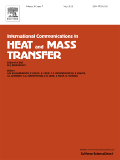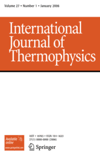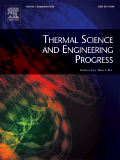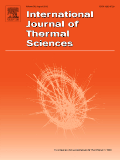
INTERNATIONAL COMMUNICATIONS IN HEAT AND MASS TRANSFER
Scope & Guideline
Advancing knowledge in thermal dynamics.
Introduction
Aims and Scopes
- Heat Transfer Mechanisms:
The journal explores various mechanisms of heat transfer, including conduction, convection, and radiation, emphasizing both theoretical models and experimental investigations. - Mass Transfer Processes:
Research on mass transfer phenomena, particularly in multiphase systems, porous media, and nanofluids, is a core focus area, highlighting the interplay between heat and mass transfer. - Advanced Materials and Nanotechnology:
The journal publishes studies concerning the application of advanced materials, including nanomaterials and hybrid systems, in enhancing thermal performance and energy efficiency. - Energy Systems and Thermal Management:
The journal covers thermal management strategies in various applications, including renewable energy systems, heat exchangers, and electronic cooling technologies. - Computational Fluid Dynamics (CFD) and Simulation:
The use of computational methods, particularly CFD, for modeling heat and mass transfer processes is a significant aspect of the journal's scope, facilitating the analysis of complex systems. - Thermal Analysis and Optimization:
Research focused on optimizing thermal systems for improved performance, including entropy generation analysis and thermal efficiency evaluations, is prominently featured.
Trending and Emerging
- Nanofluids and Hybrid Nanomaterials:
Research involving nanofluids and hybrid nanomaterials for enhanced thermal properties and energy efficiency is rapidly growing, driven by the need for improved cooling solutions in various applications. - Thermal Energy Storage Systems:
Studies focused on phase change materials (PCMs) and their integration into thermal energy storage systems are becoming increasingly popular, particularly in the context of renewable energy applications. - Machine Learning and AI Applications:
The application of machine learning and artificial intelligence to optimize heat and mass transfer processes is emerging as a significant trend, offering new methodologies for data analysis and predictive modeling. - Advanced Computational Techniques:
There is a rising interest in advanced computational techniques, including lattice Boltzmann methods and multi-scale modeling, which provide detailed insights into complex thermal systems. - Sustainable and Green Energy Technologies:
Research that emphasizes sustainable practices and the development of green energy technologies, such as solar thermal systems and energy-efficient cooling, is increasingly prominent in the journal's publications. - Thermal Management in Electronics:
The thermal management of electronic components, particularly in high-performance computing and electric vehicles, is a rapidly expanding area of research, addressing critical challenges in heat dissipation.
Declining or Waning
- Traditional Heat Exchanger Designs:
Research focusing solely on conventional heat exchanger designs without incorporating modern materials or methods has become less prevalent, as the field shifts towards innovative and hybrid designs. - Basic Heat Transfer Theory:
Papers primarily centered on fundamental heat transfer theories, without application to new technologies or materials, are becoming less common, as the focus moves towards practical applications. - Single-Phase Flow Studies:
There has been a noticeable decline in studies exclusively dealing with single-phase flow dynamics, as more researchers are integrating multiphase and nanofluid dynamics into their investigations. - Passive Heat Transfer Enhancement Techniques:
Interest in passive enhancement techniques, such as simple surface modifications, appears to be decreasing, with a shift towards active and hybrid techniques that leverage advanced technologies. - Simplistic Numerical Models:
The use of overly simplified numerical models that do not capture the complexities of real-world systems is declining, as the field increasingly values detailed and robust computational approaches.
Similar Journals

Archives of Thermodynamics
Innovating Insights into Thermodynamic ProcessesArchives of Thermodynamics is a reputable journal dedicated to the field of thermodynamics, published by the esteemed POLISH ACADEMY OF SCIENCES. With a robust history since its inception in 2003, this journal serves as a critical platform for disseminating high-quality research aimed at advancing knowledge and technology in thermodynamic systems and processes. Recognized for its contribution to the field, it holds a Q3 ranking in the Physics and Astronomy (miscellaneous) category as of 2023, with a respectable Scopus rank of #148 out of 243, placing it within the 39th percentile. Although it follows a traditional access model, the journal's commitment to scholarly excellence ensures that researchers, professionals, and students alike can benefit from its rich archives and ongoing discussions within the scientific community. Situated in Warsaw, Poland, the journal not only reflects a regional dedication to scientific progress, but also engages with global audiences interested in the evolving landscape of thermodynamic research.

Interfacial Phenomena and Heat Transfer
Unveiling the Complexities of Interfacial DynamicsInterfacial Phenomena and Heat Transfer is a leading academic journal published by BEGELL HOUSE INC that has rapidly established itself as an essential resource for scholars and industry experts in the fields of engineering, fluid flow, and chemical processes. With an ISSN of 2169-2785 and E-ISSN 2167-857X, this journal focuses on the critical interdisciplinary aspects of heat transfer and interfacial phenomena, offering insights that span across mechanical engineering, chemical engineering, and physical sciences. Despite its relatively recent inception in 2017, it has garnered respectable recognition, with a 2023 Scopus rank placing it in the Q3 category within the disciplines of Engineering (miscellaneous) and Fluid Flow and Transfer Processes, making it a pertinent publication for those interested in cutting-edge research. As researchers and professionals navigate the complexities of interfacial dynamics, Interfacial Phenomena and Heat Transfer serves as a pivotal platform, publishing high-quality, peer-reviewed articles that aim to advance knowledge and stimulate further investigation in this increasingly vital domain.

INTERNATIONAL JOURNAL OF THERMOPHYSICS
Unveiling the Science of Heat and MatterInternational Journal of Thermophysics, published by Springer/Plenum Publishers, is a premier platform for the dissemination of high-quality research in the field of thermophysics, particularly focusing on the intricate relationships between thermal properties and their applications across various scientific disciplines. With an ISSN of 0195-928X and an E-ISSN of 1572-9567, the journal has established a respected presence in the academic community since its inception in 1980, with a converged publication timeline extending to 2024. Categorized in the Q2 quartile for Condensed Matter Physics in 2023 and maintaining impressive Scopus rankings—such as #39 in Fluid Flow and Transfer Processes and #178 in Condensed Matter Physics—the journal serves as a vital resource for researchers and professionals aiming to advance knowledge in the thermal sciences. Though not an open-access journal, it remains accessible through institutional subscriptions. The International Journal of Thermophysics is committed to fostering innovative research and interdisciplinary collaboration, ensuring that it remains at the forefront of thermophysical studies.

Thermophysics and Aeromechanics
Bridging Disciplines for Tomorrow's Engineering ChallengesThermophysics and Aeromechanics, published by PLEIADES PUBLISHING INC, is an esteemed journal dedicated to advancing the fields of aerospace engineering, energy engineering, modeling and simulation, as well as nuclear and high energy physics. With an ISSN of 0869-8643 and E-ISSN 1531-8699, this journal serves as a vital platform for researchers and professionals working at the intersection of thermophysics and aeromechanics, delivering cutting-edge research, reviews, and case studies. Despite its current position in Quartile Q4 across multiple categories, including aerospace and energy engineering, it provides a unique opportunity for emerging ideas in these domains to gain visibility and impact. The journal's convergence of diverse scientific disciplines is critical for fostering innovation and technological advancements, making it an essential resource for students, practitioners, and academics alike. In this era of rapid scientific development, Thermophysics and Aeromechanics plays a pivotal role in disseminating knowledge and facilitating interdisciplinary collaboration among a global audience.

Special Topics & Reviews in Porous Media-An International Journal
Exploring Innovations in Porous Media ScienceSpecial Topics & Reviews in Porous Media-An International Journal is a prominent academic journal published by BEGELL HOUSE INC, dedicated to the exploration and innovation within the field of porous media. With an ISSN of 2151-4798 and E-ISSN 2151-562X, this journal serves as a key platform for researchers, professionals, and students engaging with topics in engineering and materials science, holding a respectable Q3 ranking in both categories as of 2023. Spanning a publication history from 2010 to 2024, the journal aims to disseminate high-quality, peer-reviewed research that addresses the complexities and advancements in porous materials, facilitating knowledge sharing and fostering collaboration. Although not an open-access journal, it ensures broad accessibility to its valuable content through institutional subscriptions. Positioned at the intersection of theory and practical applications, Special Topics & Reviews in Porous Media plays a crucial role in advancing the understanding of this interdisciplinary field and acts as a significant resource for academics and industry practitioners alike.

Journal of Thermal Science
Illuminating the path of innovation in thermal processes.Journal of Thermal Science is a prestigious academic publication dedicated to the field of thermal science and its applications. Published by SPRINGER, this journal has been at the forefront of knowledge dissemination since its inception in 1992 and continues to provide a platform for researchers and professionals to share their innovative findings through high-quality peer-reviewed articles. With its ISSN 1003-2169 and E-ISSN 1993-033X, the journal covers a diverse array of topics related to thermal processes, materials, and engineering, significantly contributing to advancements in Condensed Matter Physics. In the latest rankings, it holds a commendable Q2 category in the 2023 quartiles, further highlighting its relevance with a Scopus ranking of #183/434 in its field, placing it in the top 57th percentile. While currently not offering open access, the journal strives to bridge the gap between theory and practice, making substantial impacts on both academia and industry. Its continued exploration of cutting-edge research ensures that it remains a key resource for students and professionals looking to expand their knowledge and foster innovation in thermal sciences.

Thermal Science and Engineering Progress
Pioneering research in energy conversion and management.Thermal Science and Engineering Progress is a premier peer-reviewed journal published by ELSEVIER, established to bridge the gap between theoretical and practical advancements within the fields of thermal science and engineering. Since its inception in 2017, this esteemed journal has rapidly ascended to a Q1 ranking in the category of Fluid Flow and Transfer Processes, positioning it among the top 17 of 96 journals in this discipline, as reflected by its impressive 82nd percentile ranking in Scopus. With a focus on disseminating high-impact research, Thermal Science and Engineering Progress aims to foster innovation and collaboration by publishing cutting-edge studies that address both contemporary challenges and future directions in thermal management, energy conversion, and heat transfer technologies. Researchers, professionals, and students alike are invited to explore the wealth of knowledge contained within its pages, which are accessible from its headquarters in Amsterdam, Netherlands. This journal plays a critical role in advancing technological progress and fostering a deeper understanding of thermal processes, making it an essential resource for anyone dedicated to these crucial areas of study.

INTERNATIONAL JOURNAL OF THERMAL SCIENCES
Advancing knowledge in thermal sciences.The INTERNATIONAL JOURNAL OF THERMAL SCIENCES is a premier academic journal published by ELSEVIER FRANCE-EDITIONS SCIENTIFIQUES MEDICALES ELSEVIER, focusing on cutting-edge research in the field of thermal sciences. With its ISSN 1290-0729 and E-ISSN 1778-4166, this journal has established itself as a crucial resource for scholars and professionals interested in the thermodynamic principles governing engineering and condensed matter physics. The journal is ranked Q1 in both Condensed Matter Physics and Engineering (miscellaneous), highlighting its exceptional quality and influence, as reflected in its impressive Scopus ranks: #32 out of 307 in General Engineering (89th percentile) and #57 out of 434 in Condensed Matter Physics (86th percentile). Researchers and students alike can benefit from the wealth of articles available, with access options designed to foster a wider dissemination of knowledge within the scientific community. Established in 1973 and ongoing through 2025, the journal invites contributions that advance the understanding of thermal phenomena and their applications, solidifying its importance in driving innovation and insight within these dynamic fields.

Case Studies in Thermal Engineering
Advancing the Frontiers of Thermal Engineering ResearchCase Studies in Thermal Engineering, published by ELSEVIER, stands as a premier platform for innovative research and analysis in the field of thermal engineering since its inception in 2013. With a robust Open Access model, this journal ensures that groundbreaking findings in fluid flow and transfer processes are readily accessible to a global audience, fostering collaboration and knowledge sharing across disciplines. Situated in the United Kingdom, the journal boasts an impressive impact factor, reflecting its status in the first quartile (Q1) for both engineering (miscellaneous) and fluid flow and transfer processes, as noted in the latest Scopus rankings. Researchers and professionals alike recognize its significance, ranking 9th out of 96 in Chemical Engineering and achieving a notable 91st percentile in its category. By publishing high-quality case studies, the journal aims to advance understanding and applications of thermal engineering principles, making it an essential resource for those looking to stay at the forefront of this dynamic field.

HEAT TRANSFER ENGINEERING
Exploring the frontiers of heat transfer and engineering excellence.HEAT TRANSFER ENGINEERING is a leading international journal published by Taylor & Francis Inc, dedicated to advancing the field of heat transfer and thermal engineering. With a strong focus on the key aspects of Condensed Matter Physics, Fluid Flow and Transfer Processes, and Mechanical Engineering, this journal covers a comprehensive range of topics from experimental studies to theoretical analysis, aiming to foster innovative research and practical applications. Since its inception in 1979 and continuing through 2024, the journal has established itself as an essential resource for researchers and industry professionals alike, reflected in its solid rankings within Scopus—holding a Q2 quartile classification in multiple engineering disciplines. Although not open access, the journal ensures broad accessibility through institutional subscriptions, making cutting-edge research readily available. With its rigorous peer-review process and commitment to quality, HEAT TRANSFER ENGINEERING plays a crucial role in shaping the future of thermal management solutions and engineering practices.